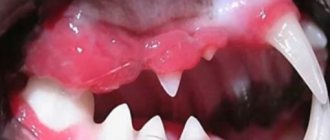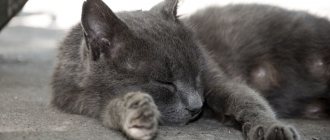Chronic renal failure is a fairly common disease in cats and cats; it mainly develops in older animals. It is believed that cats of the British, Abyssinian, Persian and Maine Coon breeds are more prone to this pathology. This disease is irreversible, but if it can be detected at the beginning of its development and treatment is started in time, the cat can live a long life and have good health.
What is chronic renal failure
The waste products of the animal body enter the kidneys through the bloodstream, and there they are filtered from toxins, which are subsequently evacuated in the urine. The role of filters is performed by the nephrons of the kidneys. A condition in which the kidneys cannot cope with their work and the cat’s body is poisoned by metabolic products is called chronic renal failure.
The development pattern of chronic renal failure suggests two options. With the first, the number of functioning nephrons decreases, and the remaining ones are forced to work with increased load. In the second, the structure of the nephrons is disrupted, and therefore the filtration rate is slowed down.
You need to know this! According to the severity, there are several stages of chronic renal failure: compensation, subcompensation, decompensation and terminal. In the first two stages, symptoms of renal failure hardly appear. At the stage of decompensation, they are quite pronounced, but the prognosis for life can still be positive under the condition of constant maintenance therapy. The terminal stage of the disease is practically a death sentence; such cats often have to be euthanized to save them from suffering.
Uremic gastritis
Author of the article: A.B. Suvorov - Candidate of Veterinary Sciences, veterinary gastroenterologist at the IVC MBA.
Attentive pet owners often notice nausea and vomiting in pets with kidney problems. Gastric dysfunction is often associated with uremia , a pathological condition that occurs due to the accumulation of protein metabolic products normally excreted in the urine. Due to irritation of the gastric mucosa by urea and other nitrogen-containing substances that accumulate in the blood, uremic gastritis develops.
Predisposing factors for this pathology are: improper diet, chronic intoxication, stress, hypothermia, pregnancy, and developmental abnormalities.
The main causes leading to uremic gastritis are acute and chronic renal failure, oncological kidney damage, glomerulonephritis with high blood pressure, poisoning, systemic diseases (diabetes, tuberculosis, etc.), as well as trauma and shock.
In animals suffering from uremic gastritis, the following clinical symptoms are noted: general weakness, anorexia, nausea and vomiting, changes in fur, the smell of ammonia, anemia, and often icterus of the mucous membranes. For the differential diagnosis of uremic gastritis, it is necessary - a clinical examination of a sick animal, a general and biochemical blood test, an ultrasound examination of the abdominal cavity, a urine test (including the protein / creatinine ratio). Radiography, gastroduodenoscopy and computed tomography are recommended as additional research methods.
In sick animals, an increase in the level of creatinine and urea in the blood serum, normocytic, normochromic, non-regenerating anemia, an increase in the level of parathyroid hormone with hypocalcemia, metastatic mineralization and metabolic acidosis are noted. In acute renal failure, hyperkalemia and hyperphosphatemia are observed. In chronic renal failure (especially in cats), hypokalemia, hyponatremia and hyperphosphatemia are noted.
When considering the pathogenesis of uremic gastritis, we can dwell on the main points:
- urea freely passes through lipid membranes and penetrates into the gastric lumen in animals with azotemia;
- fibrinoid necrosis of the vessels of the gastric mucosa occurs;
- hypergastrinemia leads to excessive production of hydrochloric acid;
- an increase in gastrin concentration causes incompetence of the pyloric sphincter and reflux of bile into the stomach;
- bacterial urease converts urea into ammonia, which causes irritation of the gastric mucosa.
The development and course of uremic gastritis is directly related to the cause that caused azotemia and will depend on a number of predisposing factors.
Often, unfortunately, the use of standard treatment regimens for gastritis is limited and requires correction due to concomitant kidney pathology. Therefore, to develop an optimal treatment plan and correct diet, consultation with a gastroenterologist and nephrologist is necessary.
Uremic gastritis is a complex multifaceted pathology that requires high-quality, timely diagnosis and the necessary symptomatic and pathogenetic therapy.
Return to list
Reasons for the development of pathology
Chronic renal failure in cats can develop as a result of injury, exposure to toxic substances, or previous infectious kidney disease (including viral peritonitis). Chronic renal failure can also be caused by:
- diseases related to the immune system;
- nephrolithiasis (kidney stone disease);
- congenital anatomical defects of renal tissue;
- the presence of benign or malignant neoplasms in the kidneys.
Cystitis is inflammation of the bladder. In cats with cystitis or disease of the lower urinary tract (uremic syndrome). Common symptoms include dysuria (difficulty urinating), pollakiuria (frequent urination), hematuria (blood in the urine), agitation, meowing when urinating, urethral obstruction or periuria (the animal urinates in new, unsuitable places). Often the owner cannot recognize that the cause of the change in behavior is a disease of the urinary system and brings the animal for examination with complaints of changes in behavior, impaired toilet habits, aggression and suspected constipation.
Feline uremic syndrome is more common in young and middle-aged cats. In younger animals, the disease is often idiopathic. In older cats, bacterial cystitis, urolithiasis (urolithiasis) or neoplasia (neoplastic growth) are more common.
Feline idiopathic cystitis. In most cases, the cause of this disease remains unclear. It is observed in young and middle-aged cats that are overweight, lead an inactive lifestyle, use a litter box, spend most of their time indoors, eat dry food, and live in houses with several pets. Males and females are equally susceptible to the disease; the risk is higher in neutered animals. Most cats with this disease experience symptoms intermittently, with varying frequencies.
Urolithiasis is defined as the formation of deposits (uroliths, or stones) in the urinary system. Urinary stones can vary in their composition. Struvite and calcium oxalate deposits are the most commonly observed deposits in cats.
Urethral plugs of the urethra and urolithiasis occur with approximately equal frequency, and are of particular importance because accompanied by blockage of the urethra. The plugs consist of various combinations of protein-colloidal matrix (albumin, globulins, cells, blood clots) and mineral material (struvite). The colloidal matrix is secreted by the bladder wall during inflammation. With severe crystalluria, blockage of the urethra can occur in the absence of a colloidal matrix, but in In most cases, crystalluria in cats is asymptomatic.
Bacterial infection rarely causes feline uremic syndrome. An increased risk of cystitis due to bacterial infection is usually associated with concomitant diseases: in 2/3 of cases in older cats, chronic renal failure (or other conditions leading to decreased urine density). In cats, bacteria grow well at low urine densities (less than 1.025), at higher densities bacterial growth is difficult (more than 1.035), and in many other cases diabetes mellitus is present. Bacterial cystitis can be iatrogenic (after catheterization). Fungal infections are rare and are usually associated with decreased immunity.
Neoplasia. Transitional cell carcinomas, adenocarcinomas, leiomyomas and a number of other tumors can form in the bladder of cats. Neoplasms are often observed as independent tumors or arise secondary to chronic inflammation.
Making a diagnosis: it is necessary to establish the specific causes of uremic syndrome (urolithiasis, urethral plugs, anatomical defects, neoplasia or bacterial infection) and separate such cases from those where the cause is not identified, that is, idiopathic cystitis.
The first step in any diagnostic examination is to determine the age, sex and breed of the patient, as well as collecting a complete analysis.
The main purpose of the clinical examination is to determine the size of the bladder, and, therefore, the presence of an indication of blockage of the urethra. In all cases, the abdomen will be painful upon palpation; in males, swelling of the foreskin and penis is often observed. In the case of idiopathic cystitis, not accompanied by urinary tract obstruction, the bladder is small, thickened and painful on palpation. While with blockage the bladder is large, full, hard, painful on palpation. In case of blockage, immediate veterinary intervention is necessary.
Laboratory research. In cats with urethral obstruction, it is important to evaluate blood biochemical parameters (potassium, urea, creatinine). In cases of severe and chronic hematuria (blood in the urine), anemia may occur due to blood loss; monitoring of a clinical blood test is necessary here.
A urine test will help clarify the diagnosis. It can be collected from the cat's litter box by placing clean, non-absorbent litter in the litter box or by removing the usual litter from the litter box.
After the diagnosis is made, the animal is assisted and symptomatic treatment is prescribed. The diet is corrected using medicinal food.
Symptoms
This disease is insidious in that it can rarely be detected in the initial stage: the first obvious signs of renal failure appear only when, due to sclerotic damage to the tissue of the renal nephrons, the organ works at less than half capacity. However, some signs of illness in a cat may suggest the development of chronic renal failure. These symptoms may differ at different stages of the disease.
Stages of compensation and subcompensation
In the early stages of the disease, the cat experiences mild malaise, loss of activity, and poor appetite. A blood test shows an elevated creatinine level. Creatinine is one of the metabolic products of amino acid-protein metabolism; its level above (250-300 µmol/l) indicates impaired renal function.
Stage of decompensation
The animal is lethargic, apathetic, and does not eat well. Despite the fact that the cat drinks a lot, he has signs of dehydration, since due to polyuria (frequent urination) all the liquid is quickly excreted. Vomiting, diarrhea or constipation are observed. Creatinine levels can reach 400 µmol/L. Ultrasound may show structural changes in the kidney tissue. At this stage, cats often experience increased blood pressure.
Terminal stage
This is the last stage of the disease, in which the animal’s condition is assessed as serious. The animal rapidly loses weight and stops eating. Uremia develops - poisoning of the body with metabolic products, and the cat develops bad breath. Serious disturbances in blood composition are observed: the concentration of potassium and phosphate ions is increased, and the calcium content is decreased, and the level of creatinine can exceed 450 µmol/l. X-rays show decreased skeletal bone density. In severe cases, the cat may develop pulmonary edema.
What is kidney failure in cats?
Renal failure in cats is a complete or partial impairment of kidney function. The pathology is accompanied by the death of parenchyma cells in the affected organs, followed by difficulty in removing metabolic products from the animal's body.
The disease affects representatives of all breeds and ages and has a variety of causes and clinical signs. This greatly complicates diagnosis at an early stage of its development.
Although kidney failure affects all breeds, it is most common in Maine Coons, Bobtails, Abyssinians, Angoras and Persians.
In addition to breed predisposition, there are other risk factors that can trigger the occurrence of renal pathology.
These include:
- diabetes;
- acute and chronic liver diseases;
- inflammation of the pancreas;
- sudden jumps in blood pressure;
- pathologies of the cardiovascular system;
- imbalance of electrolytes in the blood.
Sometimes kidney failure in a cat occurs against the background of a fever, which often leads to severe dehydration.
Diagnostics
Diagnosis of chronic renal failure in cats begins with an examination of the animal by a veterinarian and examination of the symptoms presented by the owners. If clinical signs indicate the possibility of kidney failure, laboratory tests of blood and urine are performed to confirm the diagnosis. If necessary, the cat can be prescribed hardware examination methods - radiography or ultrasound. With their help, it is possible to detect such causes of chronic renal failure as polycystic disease, tumors, and urolithiasis.
On the importance of differential diagnosis. Laboratory and instrumental studies are needed not only to differentiate chronic renal failure from other pathologies, but also to identify additional problems that have arisen against the background of the disease: anemia, water-electrolyte imbalance, mineral deficiency. Based on research data, treatment tactics for renal failure are developed and a life prognosis is given.
Treatment
It is impossible to restore kidney nephrons that have lost their functionality as a result of sclerotic changes. Therapy for chronic renal failure in cats consists of measures to preserve healthy liver cells and maintain a satisfactory level of quality of life for the animal.
For cats with stages 1 and 2 chronic renal failure, it is enough to follow a diet with a minimum amount of phosphates and proteins and a high calcium content. Your pet will have to follow this diet for the rest of its life. Food for a cat with chronic renal failure can be prepared at home, or you can buy ready-made food - special medicinal canned food for cats with liver disease is produced by almost every pet food manufacturer. Since poorly functioning kidneys require more water to evacuate toxins from the body, the cat should be given plenty to drink.
Treatment of cats with stage 3 and 4 chronic renal failure, in addition to a special diet, may include:
- constant monitoring of blood pressure, if necessary, taking medications to lower it;
- for vomiting -
gastroprotectors and antiemetics; - for anemia - vitamin B12 and hematopoietin (a hormone that stimulates the production of red blood cells);
- for hyperkalemia - administration of calcium gluconate;
- to reduce phosphorus levels - chitosan preparations;
- for the correction of electrolyte disturbances - drip infusion therapy.
To the question “How long do cats with chronic renal failure live?” we can answer that their lifespan directly depends on timely diagnosis and adequacy of treatment. If the disease was detected at an early stage and all necessary measures were taken to prevent its progression, your pet can live as long as its healthy relatives.
Acute renal failure in cats
AKI is a serious disease with rapid development of symptoms that requires immediate treatment of the cat in a clinic. At the initial stage, this process is reversible. It is accompanied by a sharp accumulation of toxic substances with changes in the electrolyte and acid-base balance in the cat’s body.
These disorders provoke the development of complications from the cardiovascular system, cause nervous disorders, vomiting, diarrhea and bleeding.
Veterinary specialists distinguish 3 types of acute renal failure in cats, depending on the cause of the pathology.
This form of the disease in cats occurs against the background of a sharp decrease in the volume of blood that passes through the renal tubules. This occurs after a significant decrease in blood pressure, which can be caused by the following reasons:
- infectious processes;
- poisoning;
- heat and sunstroke;
- extensive burns;
- shock due to the wrong choice of drug for general anesthesia;
- uncontrollable diarrhea and vomiting;
- severe dehydration of the body;
- significant blood loss;
- acute heart failure;
- traumatic shock resulting from significant tissue damage.
Note! The prerenal form of renal failure in cats occurs without damage to the renal parenchyma, so with proper treatment the process is completely reversible.
Prerenal renal failure in cats manifests itself:
- significant decrease in blood pressure;
- a decrease in body temperature below normal (in the presence of infectious processes, the temperature may rise);
- refusal of food;
- thirst;
- vomiting that does not bring relief;
- changes in the odor of urine and exhaled air (an admixture of acetone appears);
- nervous phenomena;
- severe oppression and apathy.
If the liver, heart or brain is involved in the pathological process, as well as if more than 15% of fluid in the body is lost, veterinarians give an unfavorable prognosis.
Kidney failure in cats is characterized by damage to the structural units of the organ as a result of the following factors:
- bacterial and viral infections;
- drug overdose;
- snake bites;
- blockage of the renal tubules by free hemoglobin due to mass death of red blood cells (toxoplasmosis, poisoning with hemolytic agents, sepsis);
- ingestion of heavy metal salts, aniline and its derivatives;
- inflammatory processes in the renal tubules.
Signs of kidney failure in cats can be nonspecific. These include:
- lethargy;
- digestive disorders;
- swelling;
- tachycardia;
- lack of appetite.
Characteristic symptoms of kidney failure in cats are a decrease in the amount of urine excreted with the appearance of blood in it.
Important! If the cat is completely unable to urinate, it should be urgently sent to a veterinary clinic. In this case, only timely treatment can save the animal’s life.
Veterinarians give a cautious prognosis for a cat's life, depending on the severity of kidney failure.
Postrenal insufficiency occurs due to compression or blockage of the urinary organs. The cause may be malignant or benign neoplasms, as well as urolithiasis.
The most characteristic clinical signs of post-renal failure are:
- severe pain syndrome, which is accompanied by loud or plaintive meowing, anxiety, and unnatural body position;
- difficulty urinating or its complete absence;
- pallor of visible mucous membranes;
- intoxication (vomiting, diarrhea, muscle tremors, increased temperature).
With timely restoration of urine outflow in the kidneys, irreversible changes do not have time to form. Therefore, the prognosis of treatment can be favorable or cautious. But if the symptoms indicate that the cat's kidneys are failing, there is a high likelihood of complications developing.
Prevention
To prevent the development of kidney failure in cats, their nutrition should be properly organized - the diet should contain products containing all the substances necessary for the cat’s body. Elderly animals, as well as cats of breeds included in the risk group, must undergo a routine medical examination. The examination is recommended to be carried out annually, and if your pet is over 10 years old - 2 times a year.
Veterinarian talks about chronic renal failure in cats: video










